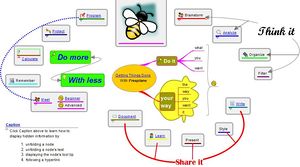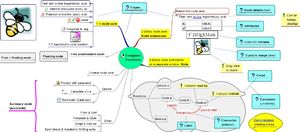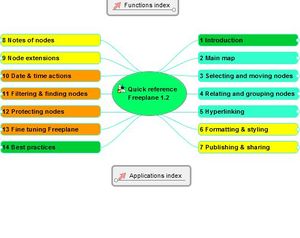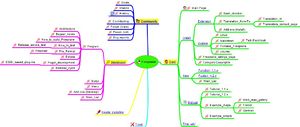Difference between revisions of "Home"
m (→Documentation) |
m (→Documentation) |
||
| Line 45: | Line 45: | ||
[[File:FreeplaneTutorial_en.jpg|thumb|right|[http://www.kioo.nl/freeplane/tutorial_en Quick reference] ]] | [[File:FreeplaneTutorial_en.jpg|thumb|right|[http://www.kioo.nl/freeplane/tutorial_en Quick reference] ]] | ||
The versatility of Freeplane is demonstrated by the fact that the main user documentation is contained in mind maps. The mind map on the right shows the ''Quick reference'' for the beginner. | The versatility of Freeplane is demonstrated by the fact that the main user documentation is contained in mind maps. The mind map on the right shows the ''Quick reference'' for the beginner. | ||
| − | The wiki page ''[[Tutorial_Freeplane|Tutorial Freeplane]]'' contains concrete examples of use cases which can be navigated and extended. For some of the examples there are animations illustrating the making of the map. The advanced user is helped with detailed ''Documentation'' in Freeplane's Help and specific wiki pages | + | The wiki page ''[[Tutorial_Freeplane|Tutorial Freeplane]]'' contains concrete examples of use cases which can be navigated and extended. For some of the examples there are animations illustrating the making of the map. The advanced user is helped with detailed ''Documentation'' in Freeplane's Help menu and by many specific wiki pages explaining things like ''[[Scripting]]'', ''[[Formulas]]'' and ''[[Add-ons]]''. The [[Mind_map_gallery| mind map galleries]] provide a place for sharing mind maps in several languages. Help is available at the open Forum, see below. |
=Community and developments= | =Community and developments= | ||
Revision as of 20:14, 7 November 2011
Boost your brain with Freeplane
Download Freeplane now!
This downloads the stable version 1.1.3
Download preview version 1.2.x
Differences between versions
Test and give your opinion.
Freeplane is free under the GNU General Public License (GPL) version 2 or later.
What is Freeplane ?
Freeplane is free and open source software to support thinking and sharing information and getting things done at work, in school and at home. The core of the software consists of functions for mind mapping, also called concept mapping or information mapping, and tools for using mapped information. Freeplane runs on any operating system on which a current version of Java is installed and from USB.
Installation
The installation of the stable version for Windows is automatic. In other cases consult the installation for different operating systems. By default an English dictionary for the spell checker is installed. Dictionaries for other languages can be downloaded and installed for for other languages. The menu structure is available in an increasingly number of languages.
The following describes the preview version Freeplane 1.2.x. For the stable version 1.1.3, see menu Navigation on the left.
Application areas and functions
Freeplane supports much more than classic, static mind mapping. This is illustrated by the mind map Application areas on the right which summarizes the kind of tasks supported by Freeplane. Click on the hyperlink below the image to navigate the map. Read the node called Caption to learn how to navigate the map and unhide hidden information. And click the node Demonstration creating a map to see how easy it is to make a map.
In the center of the map Application areas you see an elliptical form which contains the central topic (root node) of the map. Extending from it are branches with subtopics (child nodes). At the border you see free topics which are independent of the root-tree. All topics can be formatted or styled and can contain text, hyperlinks, pictures and more; and can be connected with labelled lines or arrows. Also a topic (node) can represent hidden information which shows when the user wants it or can be automatically executed (formula). Or content can be password protected or connected to a particular time or filter.
The map called Freeplane functions summarizes the main functions of Freeplane. Besides it provides an index with hyperlinks to the documentation where you can read more. The links are hidden at first, but become visible and can be clicked if you hover with the cursor over a function (node). This is another example of the power of Freeplane. Click on the hyperlink Freeplane functions below the image on the right to open the mind map and experience this behaviour yourself.
Why Freeplane?
Freeplane aims for maximum ease and speed of use. Occupying the middle ground between an editor and a diagramming tool, Freeplane allows the user to add content as quickly and naturally as they would in a text editor, yet producing structured content that can be manipulated as easily as a diagram. The workflow is unimpeded by the need to think about and manually place each piece of information; the user can intuitively input content as paragraphs and headings, and easily reorganise at a later stage. Freeplane maps can be easily integrated with Internet pages as in this wiki. And Freeplane is integrated with the Docear academic literature suite. Check the Freeplane ratings page. Finally, Freeplane offers potential programmers a versatile scripting language. Programmers may easily develop powerful extensions and students are stimulated to learn programming in a natural and stimulating environment. Freeplane also has a powerful mechanism to install packages of scripts and other preferences.
Documentation
The versatility of Freeplane is demonstrated by the fact that the main user documentation is contained in mind maps. The mind map on the right shows the Quick reference for the beginner. The wiki page Tutorial Freeplane contains concrete examples of use cases which can be navigated and extended. For some of the examples there are animations illustrating the making of the map. The advanced user is helped with detailed Documentation in Freeplane's Help menu and by many specific wiki pages explaining things like Scripting, Formulas and Add-ons. The mind map galleries provide a place for sharing mind maps in several languages. Help is available at the open Forum, see below.
Community and developments
Freeplane has its origin in problems with the popular open source mind mapping program Freemind. The Freemind software has been refactored to make it more modular and easy to contribute by new developers, and to increase the release cycle. Freeplane has been given its own logo. New developments are communicated as preview information. There are three forums. The first two are devided in developers and a users part:
Freeplane is a non-commercial project. It has an active community helping each other to get the most out of the program and developing Freeplane further. Join the freeplane team as a developer, designer, screencast producer, text writer, translator, or forum moderator, see the Freeplane vision.
This wiki
Many pages on this wiki are tagged ath the end of the page with Categories. You can click on the Category at the end of the page to display an index of all pages of the same Category. The categories and pages are summarized in the mind map Index wiki on the right.
You are invited to use this wiki to share information and tips about Freeplane and its features. You can create new pages and edit all existing pages including this one after you register and log in.
You can subscribe to atom feed to be informed about all changes in this wiki. Using this web service you can get daily e-mail notifications whenever the content changes. The same service can also be used for notifications about any changes to the project pages on SourceForge.
Thanks
Freeplane team uses:





